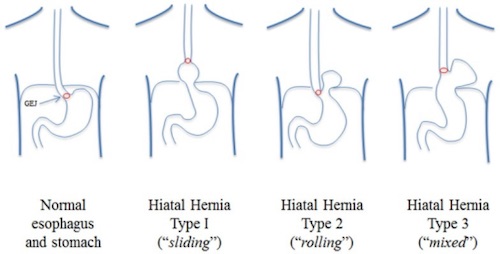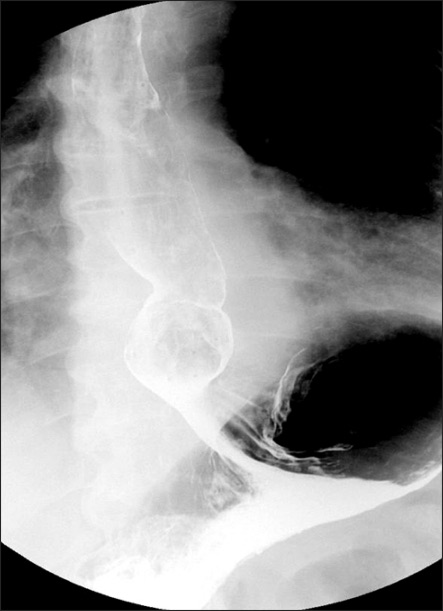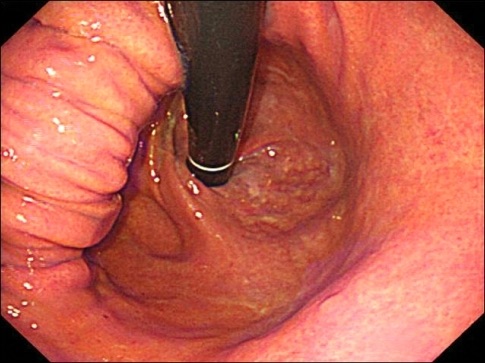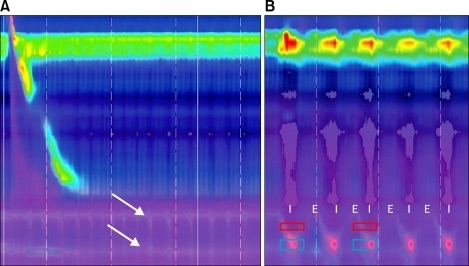Esophagus: Hiatal Hernia
Types
Sliding Hernia
- Type I: Gastroesophageal (GE) Junction Herniated Above the Diaphragm
- Most Common Hiatal Hernia (95%)
Paraesophageal/Rolling Hernia
- Type II: Part of the Stomach Herniated Above the Diaphragm Next to a Normally Positioned GE Junction
- Least Common Hiatal Hernia
- Type III: Combined Type I & Type II
- Most Common Paraesophageal Hernia (90%)
- Type IV: An Intraabdominal Organ Other than the Stomach is also Herniated Through the Hiatus (Spleen/Colon)

Hiatal Hernia Types 1
Presentation
Symptoms
- Sliding Hernia
- Highly Associated with GERD (50-94%) from GE Junction Incompetence & Impaired Esophageal Emptying
- Most are Asymptomatic & Complications are Rare
- Large Hernias Will Have GERD Symptoms (Heartburn, Regurgitation & Dysphagia)
- Paraesophageal Hernia
- GERD Symptoms are Less Common than With Type I
- Pain (Epigastric/Substernal)
- Postprandial Fullness
- Nausea & Vomiting
Complications
- Rare in Type I
- Gastric Volvulus
- Cameron Ulcers
- Ulcer of Herniated Portion
- Can Cause Chronic Blood Loss & Anemia
- *See Stomach: Peptic Ulcer Disease
- Impaired Pulmonary Function
- From Large Hernia in Thoracic Cavity Compressing the Lung
Diagnosis & Preoperative Evaluation
Diagnosis
- Usually Diagnosed Incidentally
- Intraoperatively May See “Dimpling” Anterior to Esophagus
Preoperative Testing
- Barium Esophagram
- Critical for Diagnosis & Description of Anatomy
- The Most Sensitive Diagnostic Test
- Upper Endoscopy
- Critical to Rule Out Malignancy & Evaluate Barrett’s Esophagus, Esophagitis or Ulcers
- Manometry
- Required Preoperatively to Evaluate for Concurrent Motility Disorders
- CT Scan
- Evaluates Anatomy if a Type IV is Suspected

Esophagram – Sliding HH 2

Endoscopy – Sliding HH 2

Manometry – Hypotensive Contraction 2

CT Showing Large Type IV HH 3
Treatment
Sliding Hernia Treatment
- Tx: PPI & GERD Management
Paraesophageal Hernia Treatment
- ASx: Medical Management
- Historically Recommended Prophylactic Surgery to Prevent Emergent Complications Now Mostly Advised Against
- Consider Prophylactic Surgical Repair if Progressing or Young/Fit
- Sx: Paraesophageal Hernia Repair
- Includes: Repair of Crural Defect & Fundoplication
- Repair the Crural Defect Before Fundoplication
- *See Esophagus: Fundoplication
- Requires Complete Dissection & Resection of the Hernia Sac
- Repair Defect with Permanent Suture
- Use Biologic Mesh if Large
- Similar Overall Complication Rate to Polypropylene Although Risk of Dysphagia (Biologic) is Preferred Over Erosion (Polypropylene)
- Includes: Repair of Crural Defect & Fundoplication
References
- Lebenthal A, Waterford SD, Fisichella PM. Treatment and controversies in paraesophageal hernia repair. Front Surg. 2015 Apr 20;2:13. (License: CC BY-4.0)
- Cho YK. High-resolution manometry for assessing hiatal hernia in a patient with severe reflux esophagitis. J Neurogastroenterol Motil. 2011 Oct;17(4):421-2. (License: CC BY-NC-3.0)
- Heilman J. Wikimedia Commons. (License: CC BY-SA-4.0)